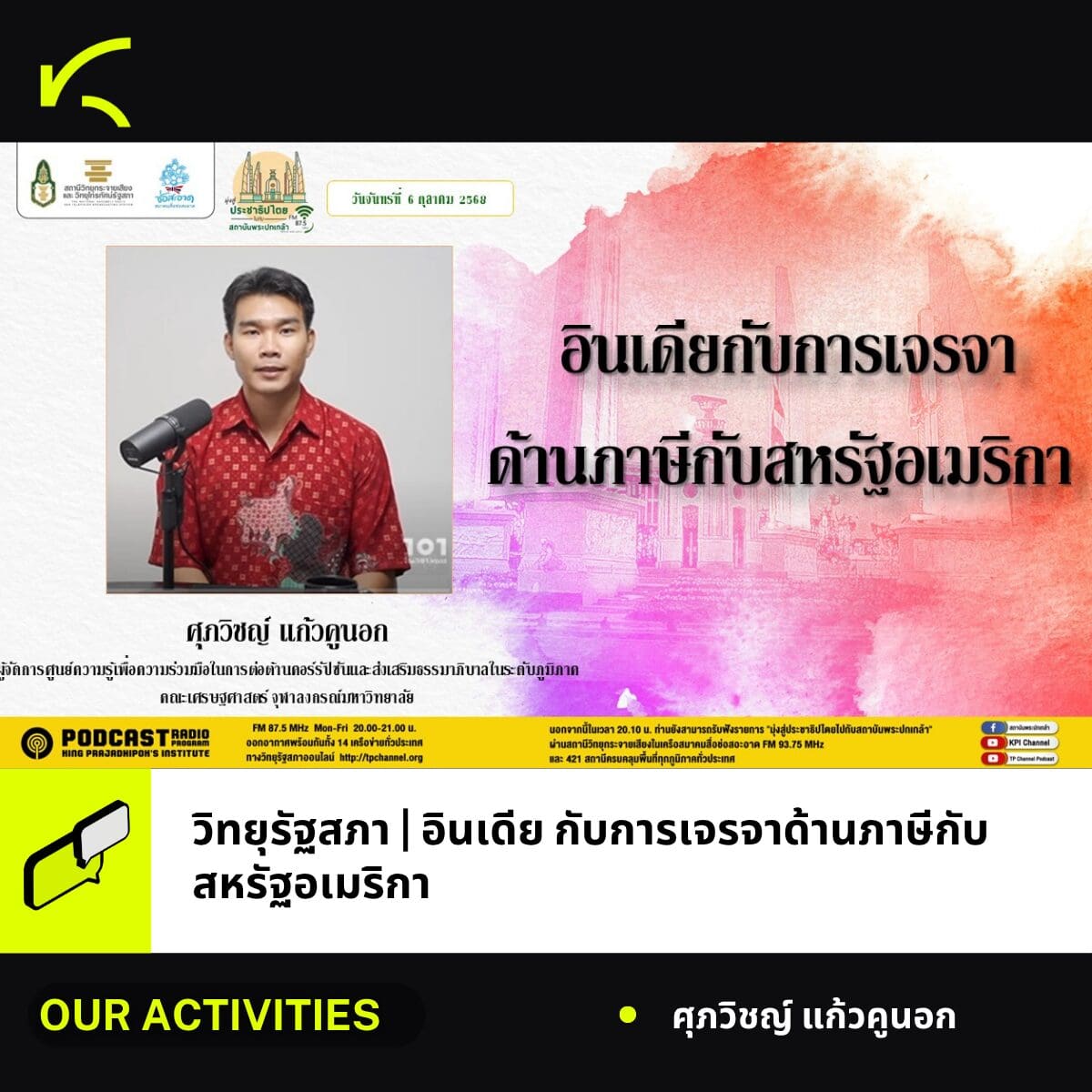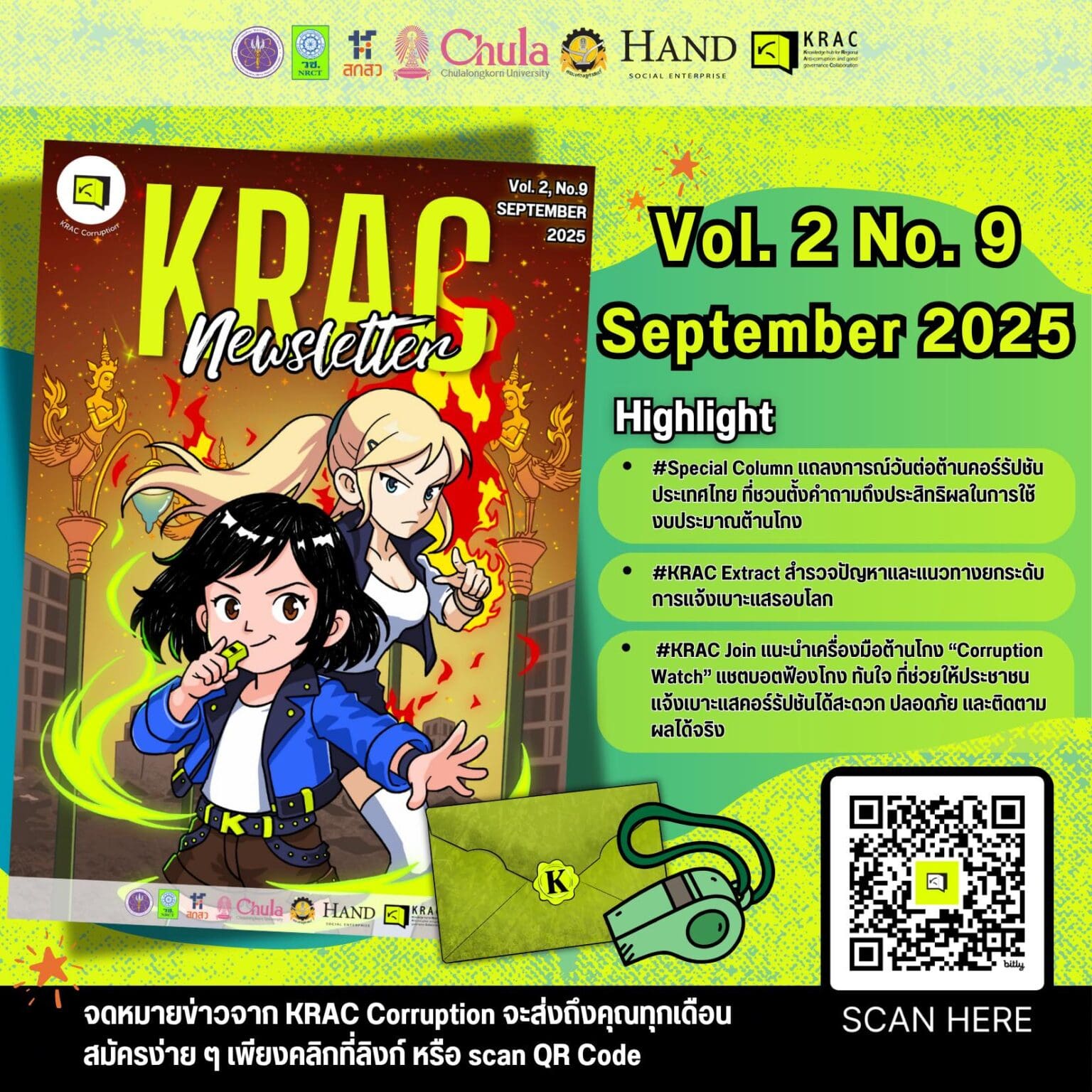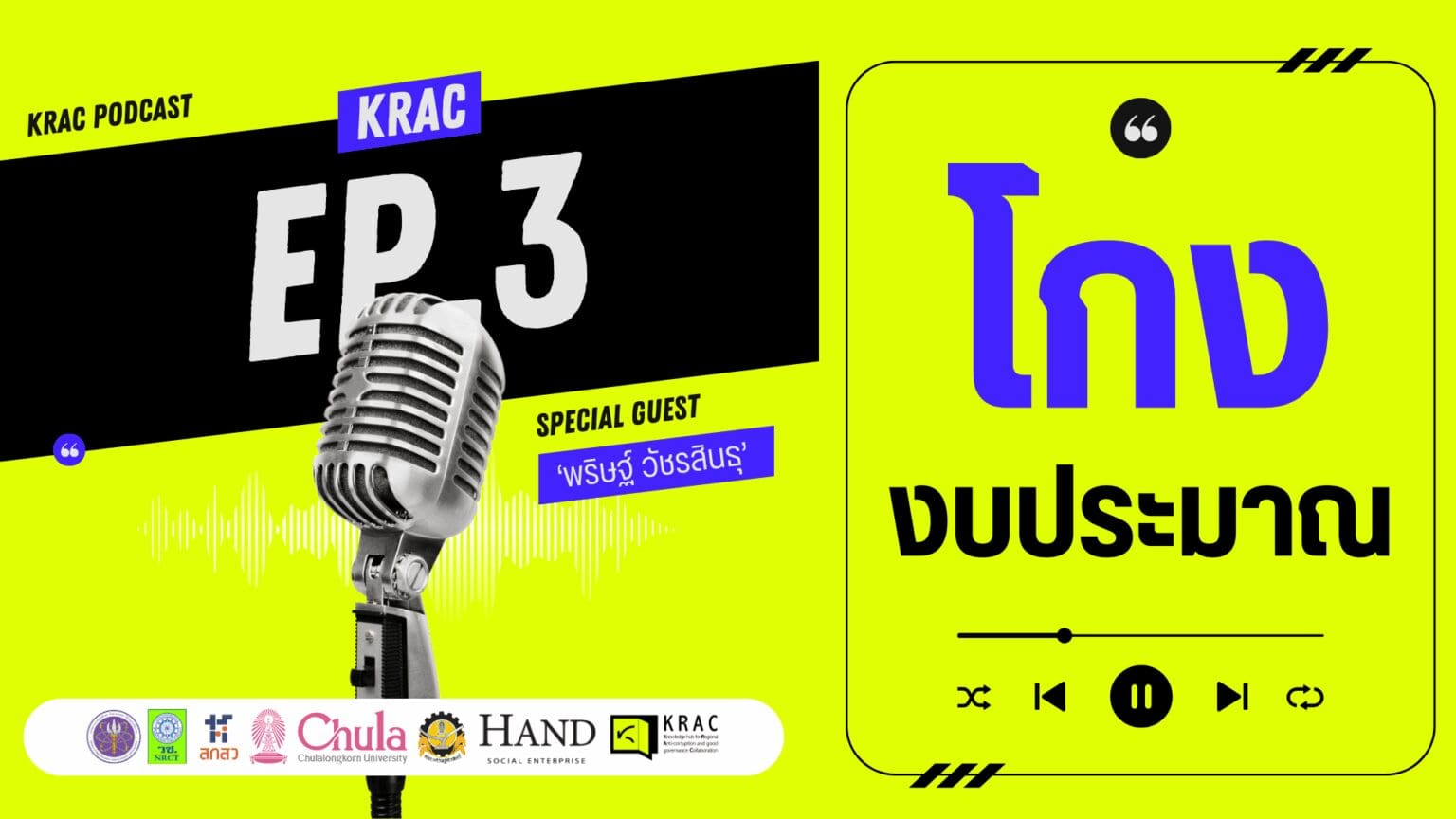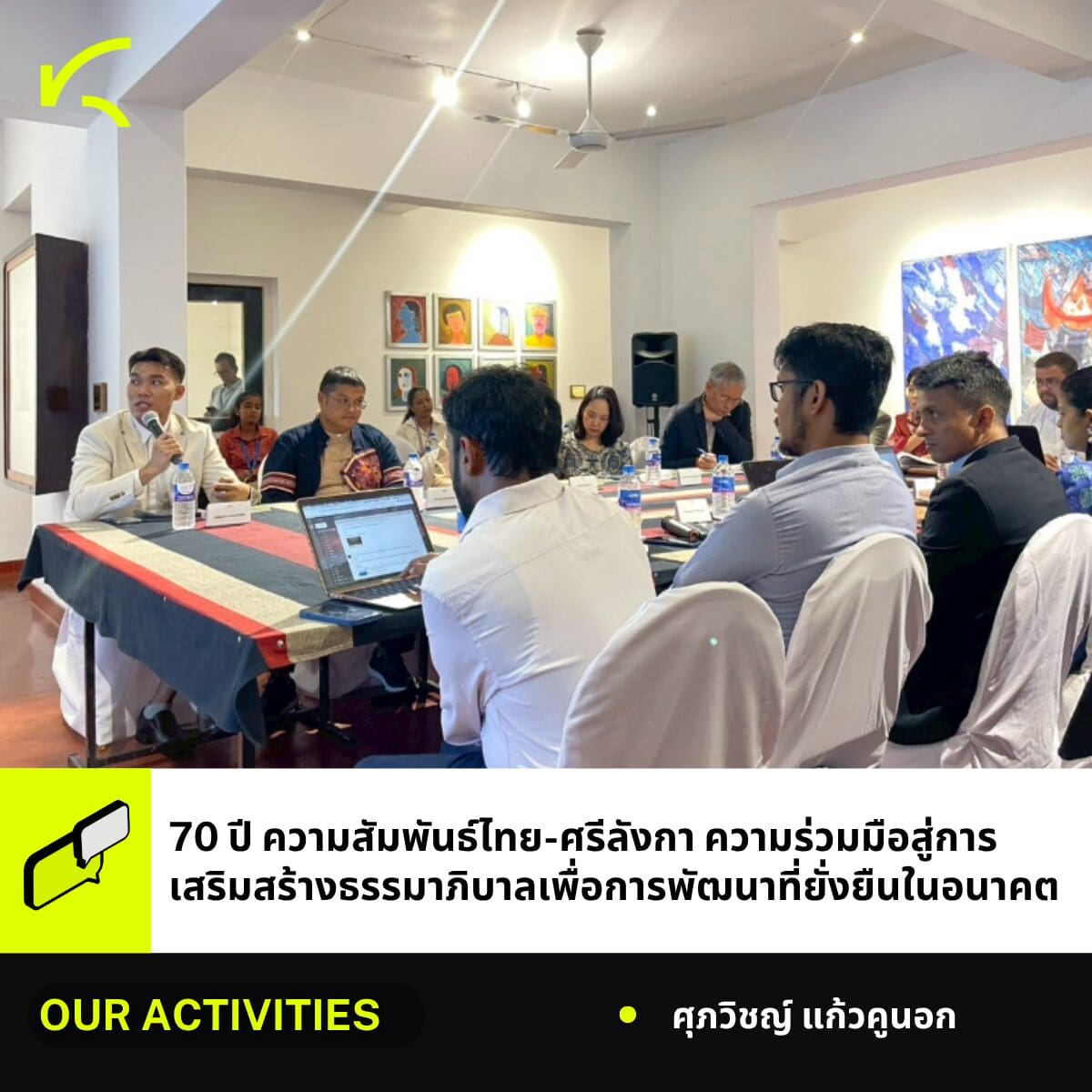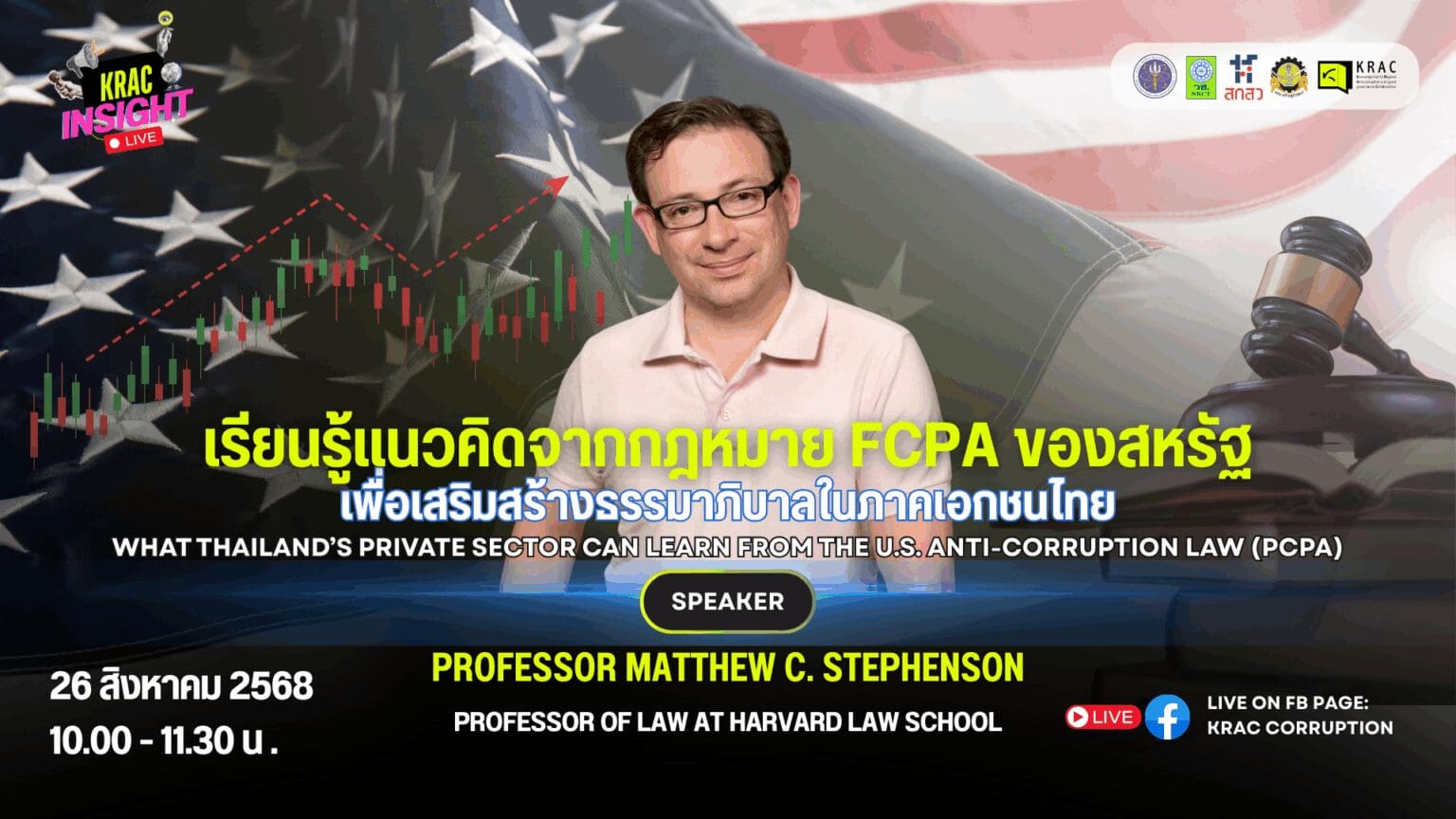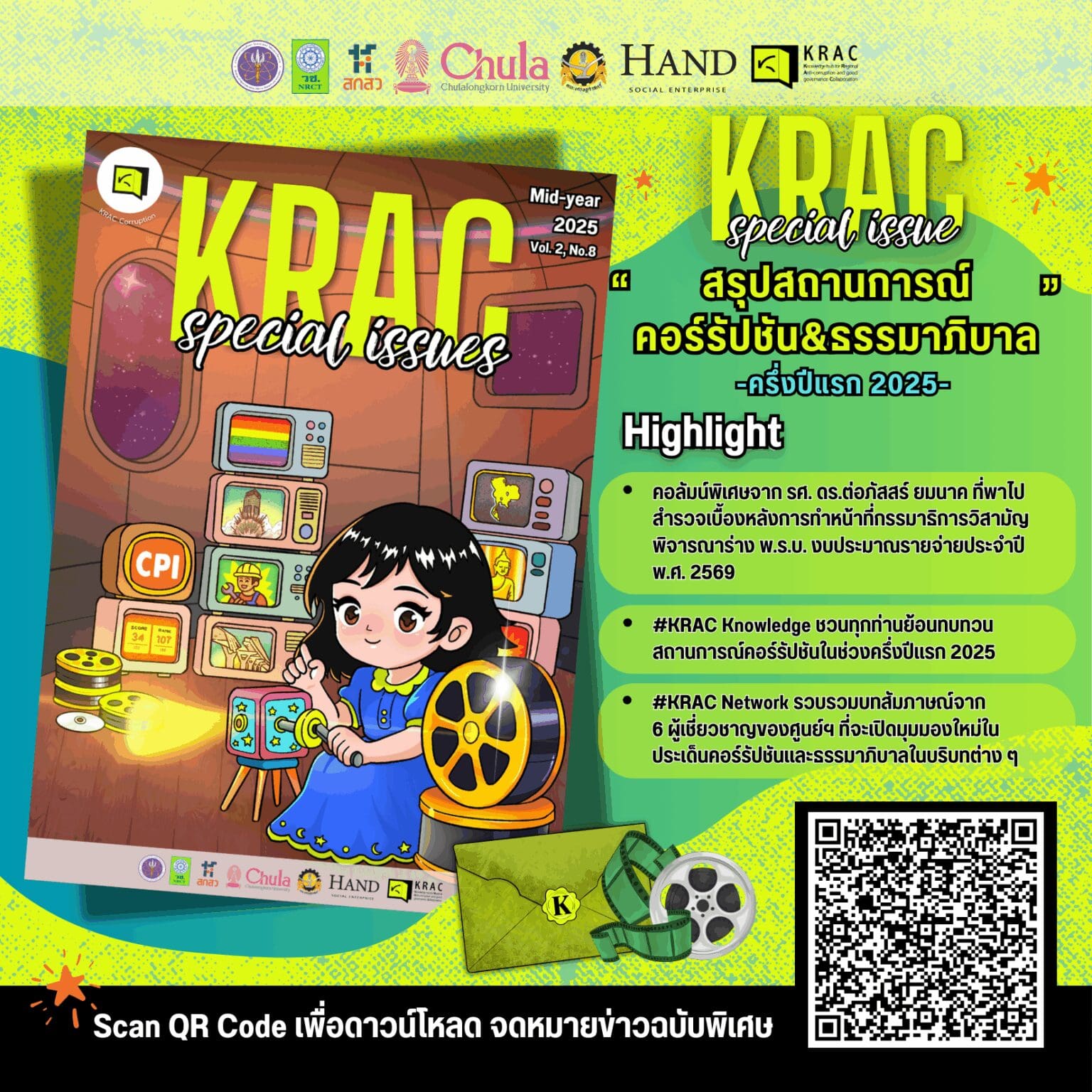
“การทุจริตเป็นภัยเงียบที่แทรกซึมเข้าสู่กระบวนการออกกฎหมายได้โดยไม่รู้ตัว” แล้วสามารถป้องกันหรือแก้ไขได้หรือไม่ ? เรามีคำตอบมาให้คุณกับงาน “การพูดคุยสาธารณะ (Public Talk)” ที่จัดขึ้นร่วมกับผู้เชี่ยวชาญระดับโลก
เมื่อวันที่ 4 ตุลาคม 2567 ศูนย์ความรู้เพื่อความร่วมมือในการต่อต้านคอร์รัปชัน และส่งเสริมธรรมาภิบาลในระดับภูมิภาค (KRAC) คณะเศรษฐศาสตร์ จุฬาลงกรณ์มหาวิทยาลัย สนับสนุนโดย สำนักงานการวิจัยแห่งชาติ (วช.) ร่วมมือกับ National Democratic Institution (NDI) จัดกิจกรรมการพูดคุยสาธารณะ (Public Talk) ในหัวข้อ “การประเมินและแก้ไขปัจจัยเสี่ยงด้านคอร์รัปชันในกระบวนการนิติบัญญัติ (Assessing and Addressing Corruption Risk Factors in Legislation)” โดยคุณ Tobias A. Dorsey ผู้เชี่ยวชาญด้านธรรมาภิบาล (Good Governance) และหลักนิติธรรม (The Rule of Law) ดำเนินรายการโดย ผศ. ดร.ต่อภัสสร์ ยมนาค ผู้อำนวยการศูนย์ KRAC และอาจารย์ประจำคณะเศรษฐศาสตร์ จุฬาลงกรณ์มหาวิทยาลัย
การพูดคุยครั้งนี้ได้กล่าวถึงคู่มือการป้องกันการทุจริตในรัฐสภา (Parliamentary Corruption-Proofing Guide) โดยคุณ Tobias กล่าวว่า “การทุจริตถือเป็นภัยเงียบที่อาจแทรกซึมเข้าไปในกระบวนการนิติบัญญัติได้อย่างไม่รู้ตัว” จึงมีหน่วยงานจัดทำคู่มือดังกล่าวที่ออกแบบมาเพื่อลดความเสี่ยงที่อาจเกิดขึ้นจากการตีความหรือบังคับใช้กฎหมายในทางที่ผิดซึ่งใช้ “แนวทางการวิเคราะห์ความเสี่ยงต่อการทุจริต (Corruption Risk Analysis: CRA)” เครื่องมือนี้ได้รับการพัฒนาโดยสหภาพยุโรป (the European Union: EU) ตั้งแต่ช่วงปี 2000 และในปัจจุบันมีการนำมาใช้ในหลายประเทศทั่วโลก ซึ่ง NDI ได้เผยแพร่คู่มือที่ปรับปรุงการวิเคราะห์ความเสี่ยงต่อการทุจริตให้มีความครอบคลุมและมีความชัดเจนมากยิ่งขึ้น
โดยคู่มือการป้องกันการทุจริตในรัฐสภาได้เน้นย้ำว่า “การป้องกันการทุจริตในกระบวนการนิติบัญญัติไม่ใช่เพียงเรื่องของการดูแลบุคคล” แต่ยังเกี่ยวข้องกับการออกแบบระบบกฎหมายให้มีความโปร่งใสและเป็นธรรม อย่างไรก็ตาม การวิเคราะห์ความเสี่ยงต่อการทุจริตไม่ใช่กระบวนการที่ตายตัว แต่ต้องอาศัยการตีความและความเข้าใจในรายละเอียดทางกฎหมายอย่างลึกซึ้ง
หนึ่งในส่วนสำคัญของคู่มือการป้องกันการทุจริตในรัฐสภาคือการนำแนวทางการวิเคราะห์ความเสี่ยงต่อการทุจริตมาใช้กับกระบวนการพิจารณากฎหมายในทุกขั้นตอน ทั้งการนำเสนอต่อคณะกรรมการ การปรับปรุงก่อนการพิจารณาในสภาผู้แทนราษฎร และการใช้การวิเคราะห์ความเสี่ยงต่อการทุจริตกับร่างกฎหมายใหม่หรือกฎหมายฉุกเฉิน
โดยคู่มือการป้องกันการทุจริตในรัฐสภา (Parliamentary Corruption-Proofing Guide) ได้เสนอแนวทางในการจัดทำรายการตรวจสอบความเสี่ยงต่อการทุจริตใน 8 ด้านสำคัญ ได้แก่ การใช้ดุลพินิจ (Discretion) การวิเคราะห์ตัวบท (Textual Analysis) ความสอดคล้อง (Consistency) การบังคับใช้กฎหมาย (Enforcement) การกำกับดูแล (Oversight) ความเป็นเหตุเป็นผล (Justification) ความโปร่งใส (Transparency) และการปรึกษาหารือ (Consultation)
ทั้งนี้องค์กรภาคประชาสังคมและเจ้าหน้าที่ภาครัฐ โดยเฉพาะเจ้าหน้าที่รัฐสภาสามารถใช้แนวทางการวิเคราะห์ความเสี่ยงต่อการทุจริต (Corruption Risk Analysis: CRA) ที่เป็นเครื่องมือสำคัญในการเตรียมการวิเคราะห์ร่างกฎหมายหรือกฎหมายที่มีอยู่ และช่วยให้คณะกรรมาธิการที่เกี่ยวข้องได้รับข้อมูลเชิงลึกในการตัดสินใจ รวมถึงการขอแก้ไขปรับปรุงร่างกฎหมายเพื่อป้องกันความเสี่ยงต่อการทุจริต ซึ่งการนำแนวทางการวิเคราะห์ความเสี่ยงต่อการทุจริตมาปรับใช้ในรัฐสภาไม่เพียงแต่จะช่วยเสริมสร้างระบบกฎหมายที่เป็นธรรมและโปร่งใส แต่ยังเป็นเครื่องมือที่ทรงพลังในการส่งเสริมความเชื่อมั่นของประชาชนที่มีต่อระบบนิติบัญญัติอีกด้วย
ทุกท่านสามารถติดตามกิจกรรมและการบรรยายที่เกี่ยวกับการแก้ไขปัญหาคอร์รัปชันของศูนย์ที่จะจัดต่อไปในอนาคต รวมถึงข้อมูลที่เกี่ยวข้องกับการคอร์รัปชันและการต่อต้านคอร์รัปชันทั้งในไทยและต่างประเทศ ได้ที่ Facebook @Kraccorruption
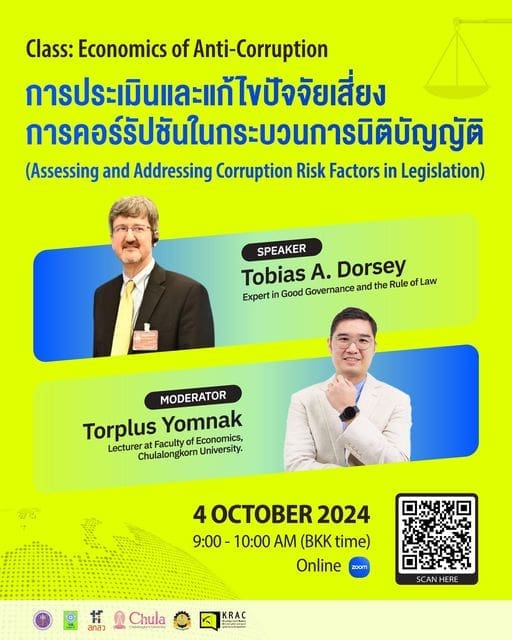
“Corruption: The Silent Threat Seeping into the Legislative Process” – Can It Be Prevented or Addressed? Find the answers at our “Public Talk” with world-renowned experts 
On October 4, 2024, the Knowledge hub for Regional Anti-corruption and good governance Collaboration (KRAC), Faculty of Economics, Chulalongkorn University, supported by National Research Council of Thailand (NRCT) in collaboration with the National Democratic Institute (NDI), hosted a Public Talk titled “Assessing and Addressing Corruption Risk Factors in Legislation” . The event featured Mr. Tobias A. Dorsey, an expert in Good Governance and The Rule of Law, moderated by Assoc. Prof. Dr. Torplus Yomnak, Director of KRAC.
The discussion introduced the Parliamentary Corruption-Proofing Guide, where Tobias A. Dorsey emphasized that “Laws can be interpreted or enforced in multiple ways, allowing for potential exploitation.” This guide is designed to reduce risks arising from the misinterpretation or misuse of laws, utilizing the Corruption Risk Analysis (CRA) tool, which was initially developed by the European Union (EU) in the 2000s. Today, this tool is widely used across the globe, with the NDI refining the guide to make CRA more comprehensive and clearer.
The guide stresses that “Corruption Risk Analysis is a powerful tool that can be incorporated into legislative processes in various ways.” The CRA is not a fixed process but requires deep legal interpretation and understanding.
One key aspect of the NDI guide is integrating CRA into Legislative Process, from Circulating the CRA before committee consideration, Updating the CRA before full chamber consideration, and Applying CRA to every bill, or after Emergency Decree.
“Parliamentary Corruption-Proofing Guide” also proposes a Checklist for Corruption Risk Analysis covering eight key areas to consider: Discretion, Textual Analysis, Consistency, Enforcement, Oversight, Justification, Transparency, and Consultation.
Both civil society organizations and government officers, particularly parliamentary staff, can use CRA to analyze current and draft legislation. This empowers relevant committees with insights to amending laws, especially to reduce corruption risks. Implementing CRA in the legislative process strengthens fairness and transparency in the legal system, enhancing public trust in the legislative process.
Stay tuned for future events and discussions from KRAC on anti-corruption efforts in Thailand and around the world. For more updates, follow us on Facebook: KRAC Corruption
หัวข้อ
- Judicial Corruption, Judiciary & Law Enforcement, Legislation Corruption
วันที่เผยแพร่
18 ตุลาคม 2567
Related Topic
